George Thomas Wilkinson Newsholme, 1852 - 1916
by Brian Stevenson
last updated September, 2021
G.T.W. Newsholme was a pharmacist who operated a major shop in Sheffield, Yorkshire, England, and served during the early 1900s as President of the Pharmaceutical Society. In his time, knowledge of the microscopical appearance of botanicals and other drug sources was an important part of a pharmacist's job. Consequently, Newsholme sold microscopes and pharmaceutical-related microscope slides (probably prepared by an assistant). It was also reported that he "conducts chemical and microscopical analyses of all kinds for private persons".
Newsholme was a significant supporter of amateur microscopy in Sheffield, serving for extended periods as Secretary and President of the Sheffield Microscopical Society. Of that society, a guidebook stated that "its prosperous condition is largely due to the exertions of its late Honorary Secretary, Mr. G.T.W. Newsholme, who at a critical time came to the rescue of the Society". However, a 1902 article in The Pharmaceutical Journal stressed that it was "incorrect to describe Mr. Newsholme as an enthusiast over the microscope", implying that he was primarily an organizer.
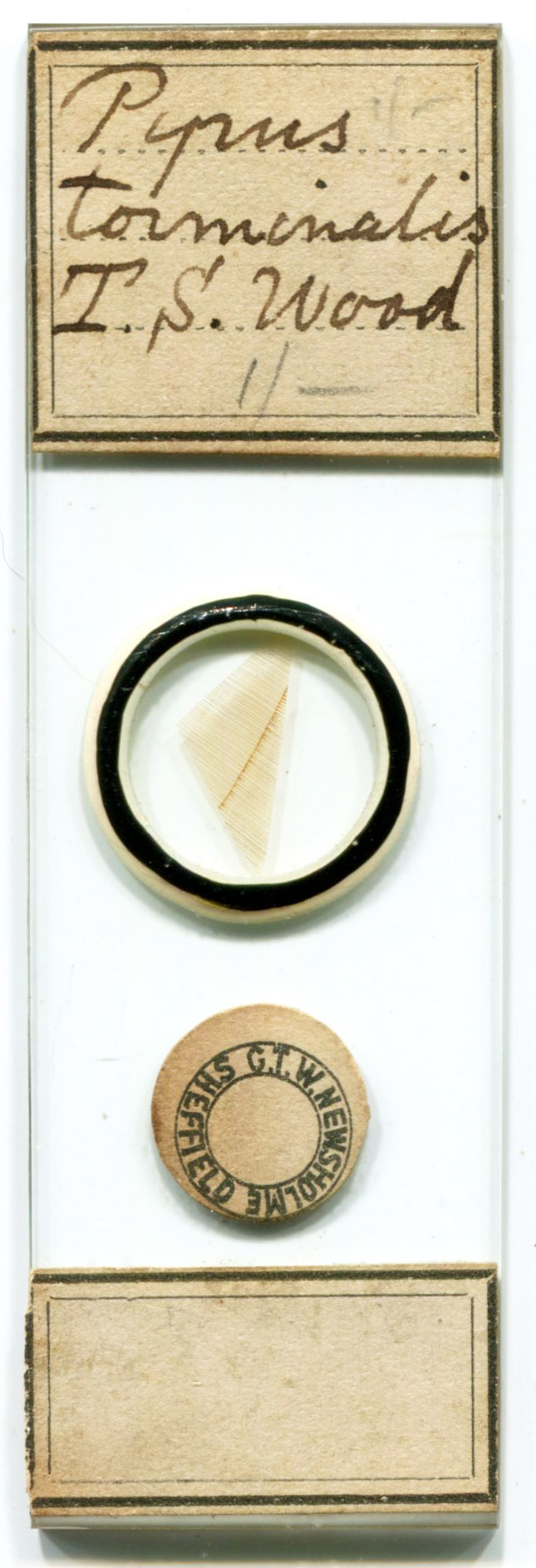
Figure 1.
A microscope slide of a transverse section of Pyrus torminalis (the wild service tree, chequers, or checker tree), labeled as having been retailed by G.T.W. Newsholme. The fruit from this plant is a traditional remedy for colic, and so it would have been important for a pharmacist to recognize it. Newsholme sold large numbers of such pharmaceutically-relevant microscope slides (see Figure 2). This slide was probably prepared by one of Newsholme's assistants, or by an outside microscopist.

Figure 2.
Published notes from "The Chemist and Druggist" 1891 (left) and 1892 (right), announcing that G.T.W. Newsholme offered prepared microscope slides for pharmacy trainees.
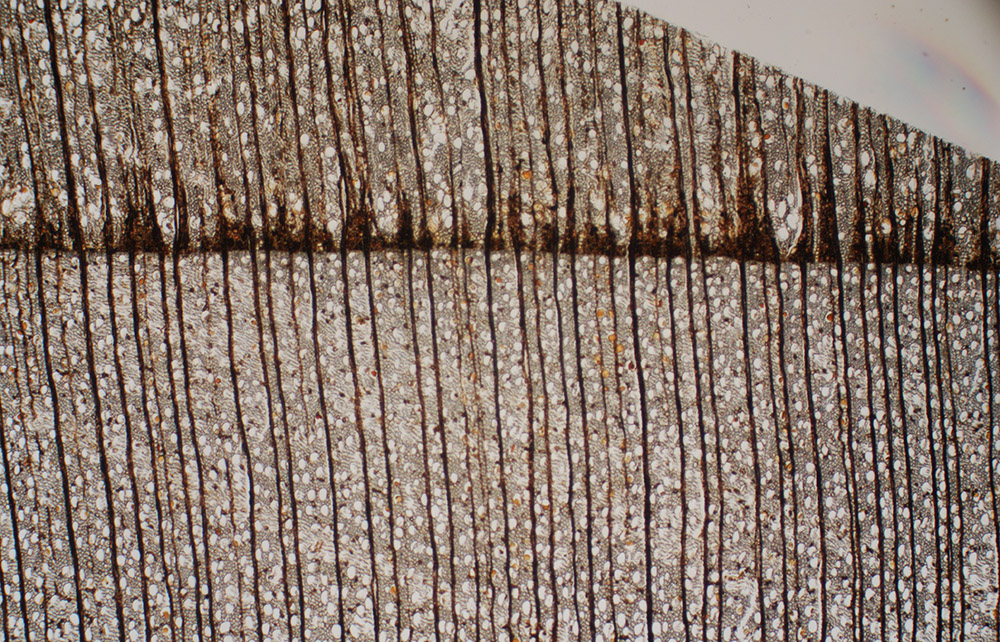
Figure 3.
Photomicrograph of a transverse section of Pyrus torminalis (see Figure 1). Photographed through a 3.5x objective lens with transmitted white light, with a C-mounted digital SLR camera on a Leitz Ortholux II microscope.
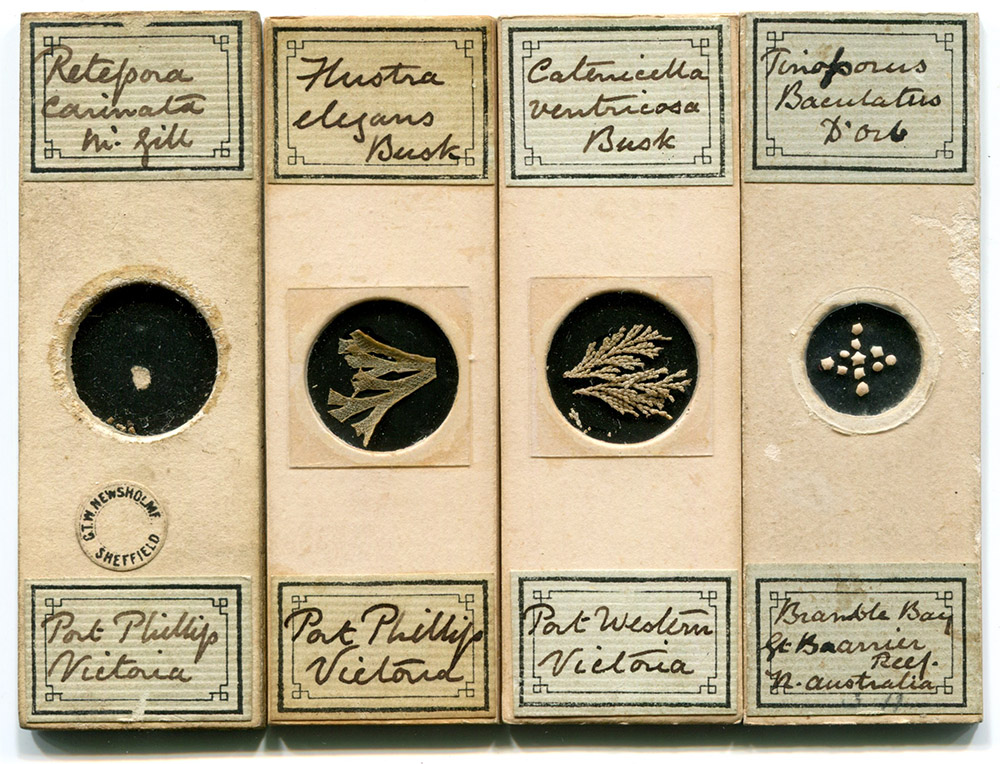
Figure 4.
Four microscope slides by an unknown mounter, one of which bears G.T.W. Newsholme's label (left side, the specimen is now lost). He may have acquired this slide for resale, or it may have once been in his personal collection.
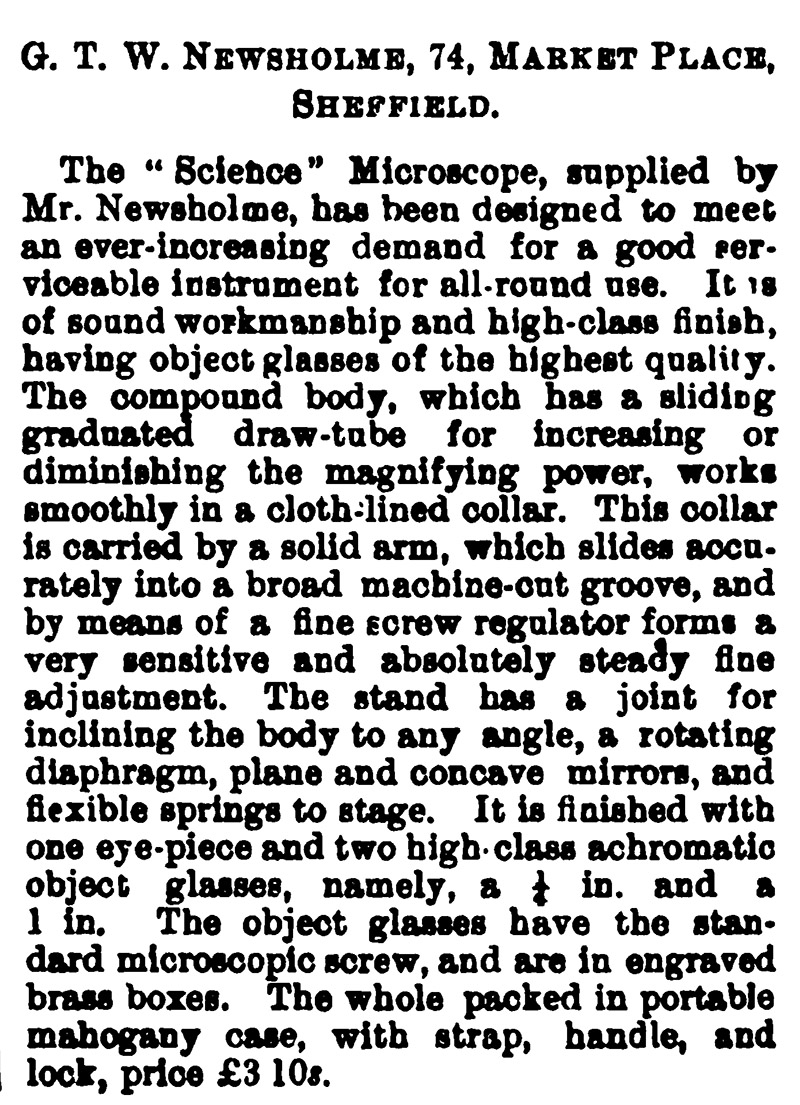
Figure 5.
A description of Newsholme's "Science" microscope, from "The Pharmaceutical Journal", 1895. Undoubtedly, the entire microscope was brought in from a wholesale manufacturer, then re-sold under Newsholme's name. This instrument was further described, "English made microscopes used to be unnecessarily costly from an extravagant outlay on the less important parts of the instrument. The demand for cheap and serviceable microscopes was long unheeded. Indeed German instruments had almost driven the English out of the field before our makers began to realise that a stand could be firm though not made of brass, and that a flat stage was at least as essential as a movable one. We have seen many cheap microscopes, but none so well worth its price as the one under review. For 70s. we have a microscope which not only looks well but is made well. The stand is firm, the adjustments serviceable and not likely to be readily deranged. There is a good low power and a quarter-inch which will do for the examination of urine and for the more ordinary microscopic observations made by the general practitioner. The leather handle attached to the case will be found very useful. The microscope can be confidently recommended to patients whose hobby is amateur natural history".
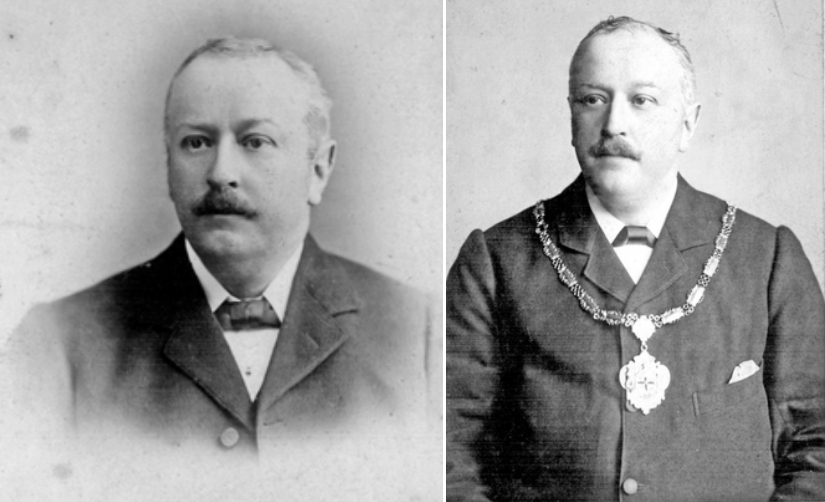
Figure 6.
Circa 1898 photographs of G.T.W. Newsholme. The medal he is wearing in the right photograph is probably the badge of office of the Chairman of the Board for the Children of the State. Images adapted for educational, nonprofit purposes from www.picturesheffield.com .
Our microscopist's surname appears to have originally been "Wilkinson Newsholme". The 1851 and 1861 national censuses list the family as "Wilkinson". George's 1852 birth record gave his name as "George Thomas Wilkinson Newsholme". The 1876 record of his registration as a pharmaceutical chemist listed him as "Wilkinson-Newsholme". But, by 1878, he was giving his name as "G.T.W. Newsholme".
George was the second child, and first son, of John and Agnes. The 1851 census listed father John as a "cabinet maker", in Settle, Yorkshire. In contrast, the 1861 censes recorded that he was a "landed proprietor" in nearby Hellifield. John, Agnes, and their now-large family of seven children lived with a young, widowed sister-in-law (an "annuitant of farm land") and enjoyed the services of a governess, housemaid, and kitchen maid. It appears that the Wilkinson Newsholmes came into a considerable amount of money during the 1850s.
As noted above, George qualified as a pharmacist in 1876. The following year, he took over the pharmacy of William V. Radley at 74 Market Street, Sheffield. The 1881 census listed Newsholme as living at the shop, along with three male assistants. From the start, Newsholme manufactured his own medicines, and advertised them nationally (Figures 7-10).
He married Augusta Sharman in 1881. The couple had five children, four girls and one boy.
Newsholme's business was described thusly in The Century's Progress (1893): "G.T.W. Newsholme, F.C.S., Manufacturing Pharmaceutical Chemist, 74, Market Place, Sheffield - For upwards of forty years this business was carried on by the late Mr. Radley in the eligible premises now occupied, and finally, in 1877, came under the sole proprietary control of Mr. G.T.W. Newsholme, a gentleman of 'light and leading' in the world of technical chemistry, who has made the name of his house famous as the birthplace of many chaste medicinal preparations of the highest utility in the treatment of alimentary disorders, of which special mention must be made of fluid malt extract; various pure preparations of pepsin and pancreatin, fluid nitrite, and solutions and decoctions of cascara, cinchona, and other valuable drugs. Mr. Newsholme's splendidly equipped laboratory is located in the High Street, and here he operates on a very extensive scale in preparing the drugs and medicines, and a very complete series of sundries for chemists and medical practitioners. Here also he conducts chemical and microscopical analyses of all kinds for private persons, commercial men, and agriculturists, such as of water, food substances, soils, &c. The premises occupied in Market Place consist of a large and handsomely appointed shop, admirably arranged to hold and display an exhaustive selection of drugs, chemicals, and pharmaceutical preparations ; and augmented at the rear by offices and warehouses. The entire business is conducted with ability and enterprise, amongst a very old-established high-class connection, composed principally of medical men, chemists and druggists, and private gentlemen; and Mr. Newsholme is everywhere respected, as much on account of his well-known integrity and honourable business methods as for his many estimable personal qualities".
In addition to pharmacy and microscopy, Newsholme had a significant interest in photography. He was a founding member of the Sheffield Camera Club, in 1888. Newsholme regularly combined his interests. For example, the minutes of an 1891 meeting of the Sheffield Medico-Chirurgical Society read, "Dr. Arthur Hall showed a series of Micro-Photographic Slides with the oxy-hydrogen lantern. They included physiological and pathological specimens, which had been taken by Mr. G.T.W. Newsholme from sections by Dr. Hall. Dr. Hall stated that his chief object in showing the specimens was to endorse what had been said and done by others lately on the great teaching value of micro-photography. The photographs, which had been taken with an ordinary camera without its lens, a Beck's microscope, and an ordinary paraffin lamp, included specimens of human retina, intestine of frog (showing the absorption of fat by the epithelium), rodent ulcer, pneumonic lung, anthrax bacilli, etc.".
Newsholme's building was demolished in 1895 to allow for widening of the street. He moved to a former jewelry shop at 27 High Street. The new premises were outfitted by the large London pharmaceutical firm of Maw, Son, and Thompson, "in their highest style, electric light, mirrors, Spanish mahogany, and labelled letters combining to make a most striking and artistic tout ensemble. The arrangement of the 'retail' reflects great credit on all concerned, and would well repay inspection by any pharmacist pissing through the city. The serving counters, the various desks, the well-lit dispensing department, and book-keeper's enclosure being all visible from the entrance, and commanded fully from the desk of the principal in the private office. The modern pharmacist does not bide away his numerous assistants in private boxes or behind high screens, and the modern public seem to enjoy the unusual and interesting sight, as testified by the numbers who frequently crowd the footpath in front of the pharmacy, as well as by the many old and new clients Mr. Newsholme has constantly to receive inside. Considering that the premises are old and had to be adapted to pharmaceutical wants, the result is astonishing, and Mr. Newsholme deserves as much credit for his ingenuity as for his enterprise. Friends at a distance will join their good wishes to that of his local friends, and wish him a long and increasing measure of prosperity".
In 1899, George Newsholme was elected to be President of the Sheffield Microscopical Society, after serving as Secretary for many years. His Presidential Address was as follows:
"In dealing with the use of the microscope from an educational point of view, it may be pointed out that, in its true sense, education consists of drawing out and strengthening and developing the various faculties and powers with which we are endowed. To train the eyes to see and the hands to handle is no small part of the education of our youth, and in this relation what instrument or means can there be so valuable as the microscope? A person working with the microscope is learning something about the object he is viewing; but more than that, he is learning to see to a degree which those who do not use this instrument cannot understand. The successful microscopist must have acquired, in a high degree, delicacy of touch, lightness, accuracy, flexibility, and steadiness of manipulation. The value of an educated hand is not properly appreciated, and yet from time to time we become practically sensible of it. It would be an easy matter to give many illustrations of its value, more particularly in relation to the practice of surgery. In every relation of life an educated eye to see and a trained hand to perform are of great importance. It may be claimed for the microscope a superiority over all other means of training these two organs. As to training the intellectual faculties, it is not possible to work honestly and industriously in any department of natural science without profitably exercising the intellectual faculties. An untrained person is liable to see a little and to imagine a great deal; but the habit of accurate observation essential to the use of the microscope develops a corresponding care to interpret correctly.
The use of the microscope for cultivating the faculty pertaining to the sense of the beautiful is another important factor in education. In the education and development of the artistic sense the microscope takes us to the beauties of the Creator's work. In the perfection this instrument reveals to us there is never a line out of drawing or a colour or tint too few or too many, and, unlike man's work, the more God's work is magnified and the clearer becomes the detail, the more beautiful does it appear. The use of the microscope in the education of the young (and I would have microscopy taught in every school in the kingdom) cannot but have the most salutary influence upon their sense of proportion and of harmony, and help them in the appreciation of all that is beautiful.
As to the use of the microscope in everyday life applied to our daily work, there are many persons who go through life and follow their several callings without knowing the amount of knowledge which the microscope would let in upon their pursuits. On the other hand, there are many in professions and trades of various kinds to whom the microscope is well nigh indispensable. The science of biology, at least, in its modern aspect in relation to botany and zoology, owes its very existence to the microscope, and the great advances in our knowledge of minute structure and growth in quite recent years have taken place in consequence of the many improvements in microscopes themselves and in microscopic methods of research, notably, the employment of various methods of staining. Indeed, at the present day it would be quite impossible to teach these sciences without the microscope.
Bacteriology, one of the most modern of sciences, owes everything to the microscope. It would be impossible to say how much the medical profession and the whole world have benefited by the discoveries in recent years of the existence of certain bacteria, the causes of many diseases. In the science of chemistry the microscope plays a most important part. Minute quantities can be recognised and many delicate chemical reactions detected. In the practice of medicine and surgery it is the indispensable instrument of the medical man.
In the practice of pharmacy it is all important. In these days of severe competition adulteration and substitution are rife. The importance of being able to tell the difference, say, between true and false ipecacuanha; between ginger which has been deprived of its active principle, and nothing but woody fibre being sold, mixed with a small quantity of the genuine article, and sold as the finest ginger; the difference between the various kinds of arrowroots, the value of which range between 4d. per lb. and 3s. 6d. per lb.; or of the various substitutes and mixtures sold for or as finest ground pepper; and many other articles I could mention. One could hardly find any trade in which the microscope does not play an important part. Its influence has been demonstrated over and over again. We know how important it is to us in buying our clothes, drapery goods, etc., that when we want silk or wool we don't get cotton, and yet I dare say many of us do not put to the test the knowledge we possess even in this matter, but I assure you adulteration in wearing apparel is equally rife with that in food and drugs, but at present unfortunately the law does not cover these articles.
In dealing with the application of the microscope to various branches of trades and professions, I am leaving to the last one of its most important ones. I mean its application to the examination of steel and iron. Sheffield may, I think, take full credit for this. The pioneer in this work was her distinguished citizen Dr. H. Clifton Sorby. Work commenced many years ago, but unfortunately not followed up by others until recent years, when another distinguished member of the Sheffield Microscopical Society - Professor Arnold - did great work, and I think he should have the credit of putting metallurgical microscopy on a satisfactory basis. This reference would not be complete without my recognising the splendid work done by Mr. B.W. Winder, of Sheffield, and also that of Mr. Thomas Andrews, F.R.S., of Wortley. Sheffield has a world-wide reputation for its steel, and the gentlemen whose names I have mentioned have done not a little in enhancing that reputation.
Notwithstanding all that has been done, there are still vast untrodden fields of discovery waiting to be explored, and the humblest worker may, by diligent and honest labour in the field of microscopy, add his contribution to the great array of facts which are daily accumulating. I trust I have succeeded in conveying to your minds who are at least some of the people to whom the microscope should appeal. You will admit that the class is a numerous one, and that a microscopical society in a town like this should, instead of its having even the large number of 154 members, have at least ten times that number. Everyone who uses a microscope for business or pleasure should join a microscopical society and attend fairly frequently its meetings, so that he may be kept well posted up in all that is new in the microscope itself and in microscopical methods that may be helpful in his special pursuit. A microscopical society should be the common meeting-ground of all interested in microscopic science. The society by its meetings should afford the opportunity to every earnest worker to bring the fruit of his labour into contact with other minds, either to be confirmed or corrected, so that he may be set on the right path by someone who has gone over the ground before. The meetings should permit the opportunity of making known to each other many of the ingenious devices and clever expedients which suggest themselves in practice, and which often make the difference between the successful and unsuccessful microscopists.
Every encouragement should be given to members to bring notes and queries to the meetings. Many observations and suggestions, in themselves valuable, are lost frequently because the opportunity has not been afforded for their notes to be recorded in a permanent form. For this purpose every society should publish a periodical report of its works. The Sheffield Microscopical Society's transactions of last year are a step in the right direction, and the yearly publication will be of great value.
Another feature of great importance to a microscopical society should be the formation of a library of the standard works of reference in microscopical literature and the formation of a museum of typical slides and specimens. In Sheffield, we have already made a very small beginning in this direction, but the lack of funds limits our extension. It is almost impossible for each microscopist to possess himself of copies of books which are essential to him if he is to do good work. The museum, I think, might grow perhaps more easily than the library if each member could think of the society when mounting slides, and mount a duplicate one at the same time.
A society may be helped in many ways - first, by becoming a member and worker with the microscope, and so contributing a quota to the share of work which the society may accomplish. Still, I hope no one will be deterred from joining a society because he has not hitherto worked with the microscope. Secondly, by paying his annual subscription, which, though small sums to him, helps to swell the fund of the society and to greatly increase its power for usefulness.
I cannot better conclude my address than by quoting, as an inducement to the study of microscopy, the following words from the presidential address of Dr. C.T. Hudson at the meeting of the Royal Microscopical Society, February 13, 1899: 'To gaze into that wonderful world which lies in a drop of water, crossed by some atoms of green weed ; to see transparent living mechanism at work, and to gain some idea of its mode of action; to watch a tiny speck that can sail through the prick of a needle's point; to see its crystal armour flashing with ever-varying tint, its head glorious with the halo of its quivering cilia; to see it gliding through the emerald stems, hunting for its food, snatching at its prey, fleeing from its enemy, chasing its mate (the fiercest of our passions blazing in an invisible speck); to see it whirling in a mad dance to the sound of its own music, the music of its happiness, the exquisite happiness of living - can anyone who has once enjoyed the sight ever turn from it to mere books and drawings without the sense that he has left all fairyland behind him?"
In 1900, he was elected President of the Pharmaceutical Society, and held the office for the next three years. It was remarked that he was the first "President who lived in a provincial town".
Newsholme was active in political and charity circles. In 1902, The Pharmaceutical Journal wrote that "according to the Sheffield Independent, the 'leading Conservative, and least conservative', member of the Sheffield Board of Guardians, 'of which he has been chairman by general acclaim'. He was an ardent co-operator with Alderman Wycliffe Wilson in establishing the Sheffield Children's Homes, whilst as a chemist he has laboured to raise the status of his calling."
His health began to fail in late 1915. The January 29, 1916 issue of The Chemist and Druggist wrote, "Mr. G.T.W. Newsholme's health is again unsatisfactory, and he has temporarily had to relinquish public duties". The March 9, 1916 issue of Nature included, "The death has occurred at Sheffield, in his sixty fourth year, of Mr. G.T.W. Newsholme, who was the first provincial pharmacist to occupy the position of president of the Pharmaceutical Society. Mr. Newsholme became vice-president of the society in 1897, and in 1900 was elected president, holding the office for three years. He was a governor of Sheffield University".
The business had become G.T.W. Newsholme, Ltd. before his death, and continued under that name for several years afterward.
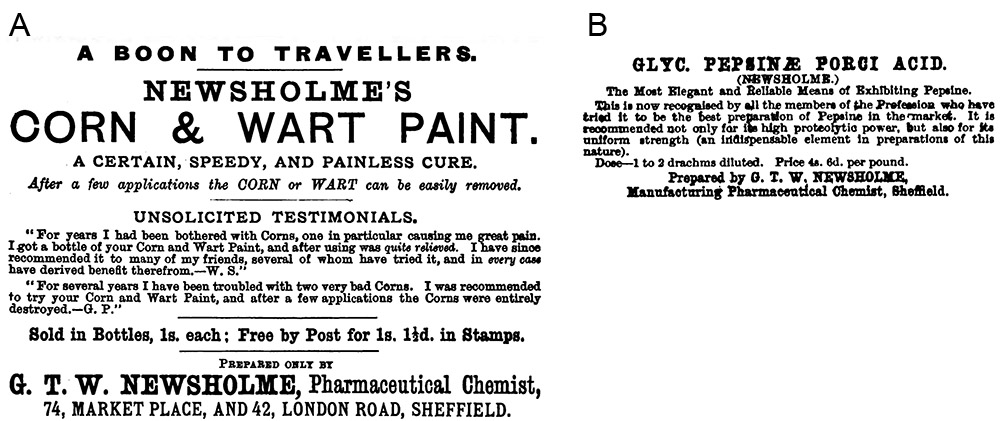
Figure 7.
Advertisements for medicines that were produced by G.T.W. Newsholme, from "Cook's Handbook for London" (1884) and "The Lancet" (1885).
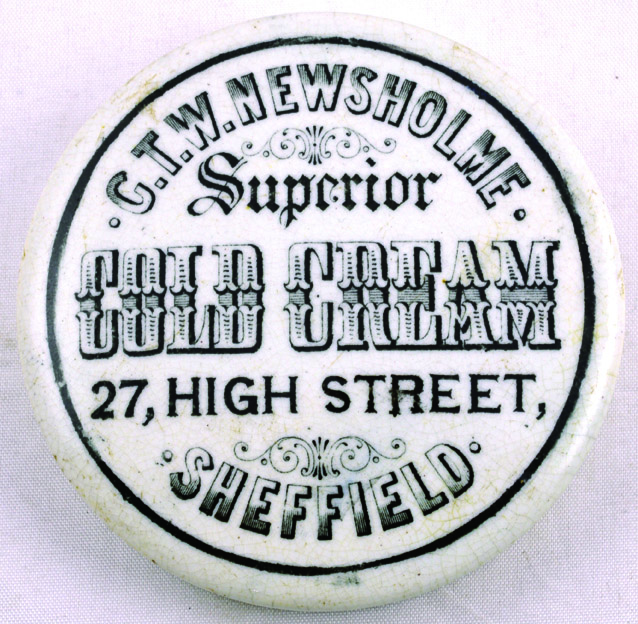
Figure 8.
Lid from a ceramic jar of cold cream, printed with Newsholme's post-1895 address of 27 High Street. Adapted for nonprofit, educational purposes from an internet auction site.
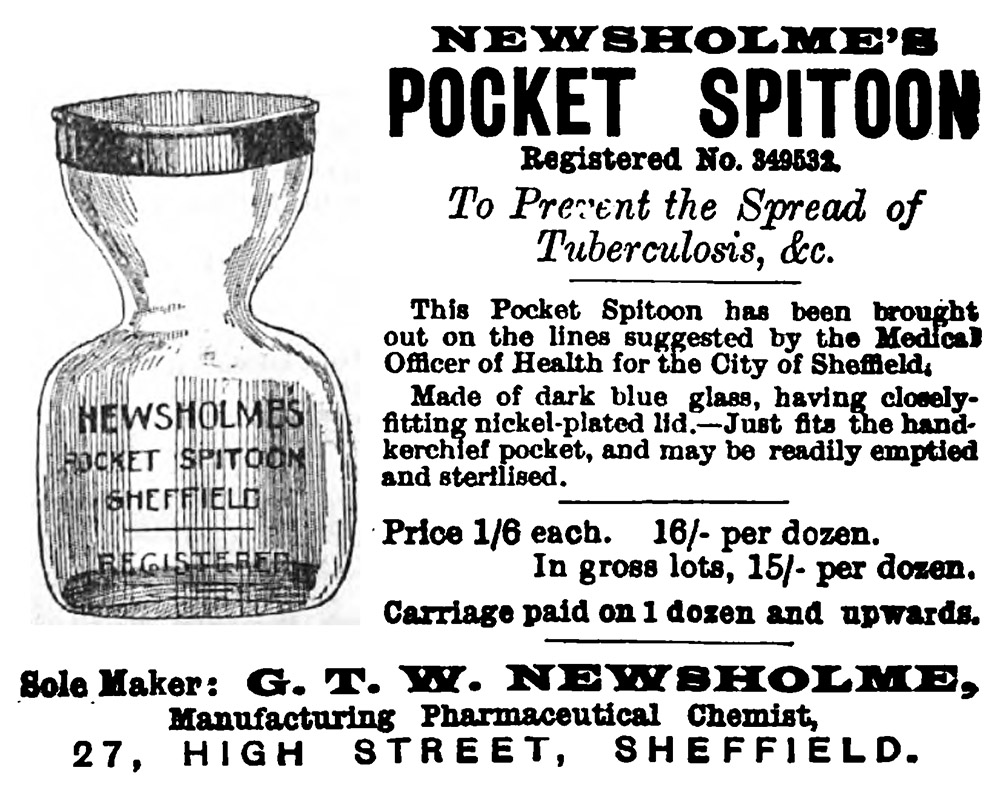
Figure 9.
Advertisement for Newsholme's "Pocket Spitoon", from "The Lancet, 1900.
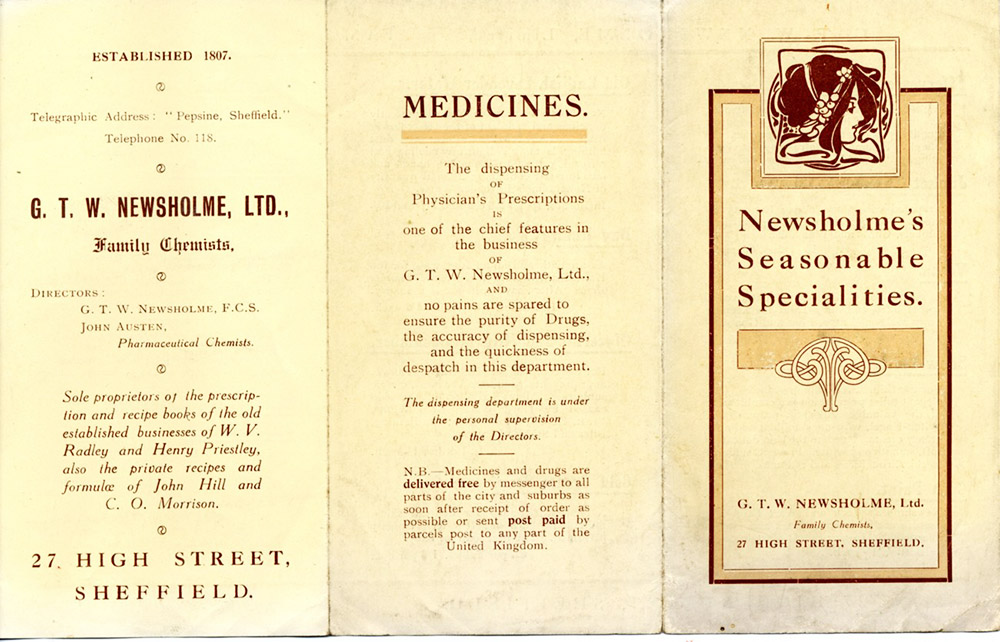
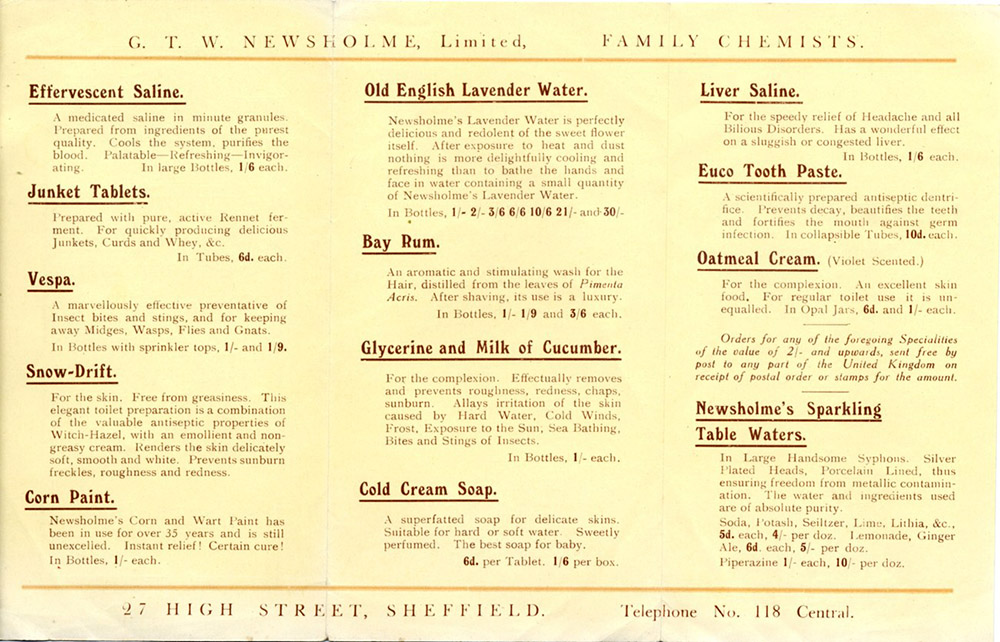
Figure 10.
An undated flyer from G.T.W. Newsholme, Ltd. It lists Newsholme as a director, and so presumably dates from before his 1916 death. Adapted for nonprofit, educational purposes from https://www.sheffieldhistory.co.uk/forums/topic/13251-newsholme39s-seasonal-specialities/
Resources
Bracegirdle, Brian (1998) Microscopical Mounts and Mounters, Quekett Microscopical Club, London, page 70
The British Medical Journal (1891) Sheffield Medico-Chirurgical Society, page 468
The Century's Progress: Yorkshire (1893) "G.T.W. Newsholme, F.C.S.", page 139
The Chemist and Druggist (1891) page 429
The Chemist and Druggist (1892) page 55
The Chemist and Druggist (1916) page 117
Cook's Handbook for London (1884) Advertisement from G.W.T. Newsholme, Thomas Cook and Son, London, page 117
England census and other records, accessed through ancestry.com
Handbook & Guide to Sheffield (1910) The Sheffield Microscopical Society, pages 204-205
Kelly's Directory of Chemists and Druggist (1921) "Chemists – Manufacturing … Newsholme G.T.W. Ltd. 27 High st", page 297
The Lancet (1885) Advertisement from G.W.T. Newsholme, July 4 advertiser
The Lancet (1890) Advertisement from G.W.T. Newsholme, June 30 advertiser
Nature (1916) Obituary of G.T.W. Newsholme, Vol. 97, page 42
Newsholme, G.T.W. (1895) The use of the microscope, Pharmaceutical Journal, Vol. 63, pages 526-527
Pharmaceutical Journal (1895) The choice of a microscope, Vol. 55, supplementary pages xiii - xiv
Pharmaceutical Journal (1895) Demolition of an ancient pharmacy, Vol. 55, page 21
Pharmaceutical Journal (1895) A new Sheffield pharmacy, Vol. 55, page 130
Pharmaceutical Journal (1900) "Three new inventions introduced some little time ago by Mr. G.T.W. Newsholme, 27, High Street, Sheffield, are of especial interest now that winter is approaching. Newsholme's Portable Ammonium Chloride Inhaler (1s. 9d. each) is simple, cheap, and compact, is easily charged and cannot get out of order. Newsholme's Pocket Spittoon (1s. 6d. each) has been designed to prevent the spread of tuberculosis, etc. It just fits the handkerchief pocket, and may be readily emptied and sterilised. Newsholme's Antiseptic Inhaler (1s.) is claimed to be far ahead of anything of the kind yet produced. It is light and flexible, elegant and cheap", Vol.65, November 24 issue, page f
Pharmaceutical Journal (1902) Mr. G.T.W. Newsholme, Vol. 69, page 175
Pharmaceutical Journal (1902) Pharmaceutical Society of Great Britain, Vol. 69, page 467
The Photographic News (1888) Sheffield Camera Club, pages 304 and 319
Post Office Directory of Sheffield (1854) "Radley William Valentine, chemist & druggist, 74 Market pl", page 123
Probate of the will of G.T.W. Newsholme (1916) "Newsholme George Thomas Wilkinson of 16 Priory-road Sheffield died 29 February 1916 at 64 Clarkgrove-road Sheffield Probate London 7 November to Augustus Newsholme widow. Effects £7421 8s", accessed through ancestry.com
The Register of Pharmaceutical Chemists and Chemists and Druggists (1885) "1876, July 12, Wilkinson-Newsholme, George Thomas", page 269
The Sheffield Medical Journal (1891) "Newsholme's Digestives - Mr. Newsholme, Sheffield, has given great attention to pepsin and pancreatin, and has succeeded in producing reliable and active preparations of these digestive principles. We can strongly recommend his Acid Glycerine of Pepsine. Half a drachm of this fluid, with eight ounces water and twenty minims hydrochlor. acid, will dissolve at the temperature of the body, more than an ounce of hard-boiled egg albumen. In his Glycerinum Pankreatos will be found a useful and ready means of peptinising milk. His peptone suppositories are supplied in two sizes. Anyone can administer them, and they are well retained by patients", Vol. 1, page 77
The Sheffield Medical Journal (1893) The Science microscope, Vol. 1, page 251
The Sheffield and Rotherham Independent (1878) Advertisement from G.W.T. Newsholme, November 28 issue, page 1
The Year-book of the Scientific and Learned Societies of Great Britain and Ireland (1890) Sheffield Microscopical Society, page 108










